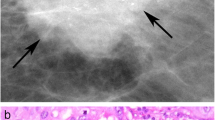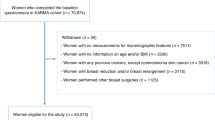Abstract
Background
The presence of microcalcification on mammography is one of the earliest signs in breast cancer detection. However, it is difficult to distinguish malignant calcifications from benign calcifications. The aim of this study is to evaluate correlation between changing patterns of microcalcification on screening mammography and malignant breast lesions.
Methods
Medical records and diagnostic images of 67 women who had previously undergone at least two digital mammograms at least 6 months apart and underwent mammography-guided needle localization and surgical excision between 2011 and 2013 were retrospectively reviewed and analyzed.
Results
Breast cancer was detected in the surgical specimens of 20 patients (29.9 %). Annual change of extent of microcalcification on mammography showed statistically significant correlation with pathologic outcome (P = 0.023). The changing pattern of new appearance or increased extent of microcalcification on mammography had positive predictive value of 54.8 % for breast cancer, and it was a statistically significant predictor for breast cancer (P = 0.012). Shape or number change of microcalcification without increased extent had less accurate predictive value for breast cancer, particularly in women younger than 50 years (P < 0.001).
Conclusions
This study showed that the pattern of increased extent of microcalcification on screening mammography was a significant predictor for breast cancer. We suggest that mammography-guided needle localization and surgical excision should be considered when increased extent of microcalcification is observed on screening mammography and closed follow-up without pathologic confirmation can be permitted if absence of extension of microcalcification was confirmed in women younger than 50 years.



Similar content being viewed by others
References
Penston J. Should we use total mortality rather than cancer specific mortality to judge cancer screening programmes? Yes. BMJ. 2011;13:343.
Marmot MG, Altman DG, Cameron DA, Dewar JA, Thompson SG, Wilcox M. The benefits and harms of breast cancer screening: an independent review. Br J Cancer. 2013;108:2205–40.
Scaranelo AM, Eiada R, Bukhanov K, Crystal P. Evaluation of breast amorphous calcifications by a computer-aided detection system in full-field digital mammography. Br J Radiol. 2012: 85517-22.
Masroor I, Afzal S, Shafqat G, Rehman H. Usefulness of hook wire localization biopsy under imaging guidance for nonpalpable breast lesions detected radiologically. Int J Womens Health. 2012;4:445–9.
Kouskos E, Gui GP, Mantas D, Revenas K, Rallis N, Antonopoulou Z, et al. Wire localisation biopsy of non-palpable breast lesions: reasons for unsuccessful excision. Eur J Gynaecol Oncol. 2006;27:262–6.
Berg WA, Blume JD, Cormack JB, Mendelson EB, Lehrer D, Böhm-Vélez M, et al. Combined screening with ultrasound and mammography vs mammography alone in women at elevated risk of breast cancer. JAMA. 2008;299:2151–63.
Saslow D, Boetes C, Burke W, Harms S, Leach MO, Lehman CD, et al. American Cancer Society guidelines for breast screening with MRI as an adjunct to mammography. CA Cancer J Clin. 2007;57:75–89.
Ciatto S, Rosselli Del Turco M, Burke P, Visioli C, Paci E, Zappa M. Comparison of standard and double reading and computer-aided detection (CAD) of interval cancers at prior negative screening mammograms: blind review. Br J Cancer. 2003;89:1645–9.
Bent CK, Bassett LW, D’Orsi CJ, Sayre JW. The positive predictive value of BI-RADS microcalcification descriptors and final assessment categories. AJR Am J Roentgenol. 2010;194:1378–83.
Uematsu T, Kasami M, Yuen S. Usefulness and limitations of the Japan Mammography Guidelines for the categorization of microcalcifications. Breast Cancer. 2008;15:291–7.
Shin HJ, Kim HH, Ko MS, Kim HJ, Moon JH, Son BH, et al. BI-RADS descriptors for mammographically detected microcalcifications verified by histopathology after needle-localized open breast biopsy. AJR Am J Roentgenol. 2010;195:1466–71.
Birdwell RL, Ikeda DM, O’Shaughnessy KF, Sickles EA. Mammographic characteristics of 115 missed cancers later detected with screening mammography and the potential utility of computer-aided detection. Radiology. 2001;219:192–202.
Pijnappel RM, Peeters PH, Hendriks JH, Mali WP. Reproducibility of mammographic classifications for non-palpable suspect lesions with microcalcifications. Br J Radiol. 2004;77:312–4.
Ko BS, Noh WC, Kang SS, Park BW, Kang EY, Paik NS, et al. Changing patterns in the clinical characteristics of korean breast cancer from 1996–2010 using an online nationwide breast cancer database. J Breast Cancer. 2012;15:393–400.
Venturini E, Losio C, Panizza P, Rodighiero MG, Fedele I, Tacchini S, et al. Tailored breast cancer screening program with microdose mammography, US, and MR Imaging: short-term results of a pilot study in 40–49-year-old women. Radiology. 2013;268:347–55.
Chae EY, Kim HH, Cha JH, Shin HJ, Kim H. Evaluation of screening whole-breast sonography as a supplemental tool in conjunction with mammography in women with dense breasts. J Ultrasound Med. 2013;32:1573–8.
Nothacker M, Duda V, Hahn M, Warm M, Degenhardt F, Madjar H, et al. Early detection of breast cancer: benefits and risks of supplemental breast ultrasound in asymptomatic women with mammographically dense breast tissue. Syst Rev BMC Cancer. 2009;9:335.
Boyd NF, Guo H, Martin LJ, Sun L, Stone J, Fishell E, et al. Mammographic density and the risk and detection of breast cancer. N Engl J Med. 2007;356:227–36.
Kettritz U, Morack G, Decker T. Stereotactic vacuum-assisted breast biopsies in 500 women with microcalcifications: radiological and pathological correlations. Eur J Radiol. 2005;55:270–6.
Acknowledgments
The authors declare that they have no competing interests.
Author information
Authors and Affiliations
Corresponding author
About this article
Cite this article
Kim, K.I., Lee, K.H., Kim, T.R. et al. Changing patterns of microcalcification on screening mammography for prediction of breast cancer. Breast Cancer 23, 471–478 (2016). https://doi.org/10.1007/s12282-015-0589-8
Received:
Accepted:
Published:
Issue Date:
DOI: https://doi.org/10.1007/s12282-015-0589-8




